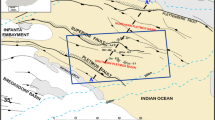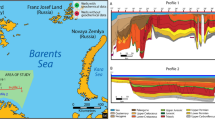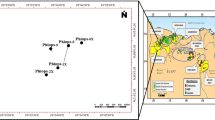Abstract
Southern Lower Indus basin is an oil and gas prone basin, which is important for producing hydrocarbon in Pakistan. Due to limited Rock-Eval pyrolysis data availability in the prospective shale gas basin, the organic facies geochemical characteristics study is a challenging task for researchers. The primary objective of this study is an evaluation of the Lower Goru Formation organic facies hydrocarbon potential by geochemical data and its subsurface facies distribution study by well tops and seismic data. The study area is situated at the Southern Lower Indus basin of Pakistan that is considering the prospective shale gas basin with immense unconventional hydrocarbon potential. In the present study, Rock-Eval pyrolysis data analysis along with the integration of both seismic and well tops data were conducted for investigation of source rock generation potential of organic facies variability within the Lower Goru Formation. The geochemical approaches used in the current study show that the Lower Goru Formation encountered in, bears fair to excellent total organic carbon (TOC) content values of 0.50–3.60% in Well-A and 0.10–4.69% in Well-B. Additionally, the results of Rock-Eval pyrolysis data show that interbedded shales of the Lower Goru Formation contain different types of kerogen (III, II–III, and II) with variable generation potential of oil and gas.
Research highlights
-
The study area is located in the Southern Lower Indus basin of Pakistan which is considering the prospective shale-gas basin with immense unconventional hydrocarbon potential.
-
The integration of geophysical and geochemical data is a predictive tool for the source rocks evaluation.
-
In this article, we incorporate seismic and geochemical data to evaluate organic facies geochemical characteristics and subsurface geological structure.
-
Lower Goru facies have fair to very good potential to produce hydrocarbon.














Similar content being viewed by others
References
Ahmad N and Chaudhry S 2002 Kadanwari Gas Field, Pakistan: A disappointment turns into an attractive development opportunity; Petrol. Geosci. 8(4) 307–316.
Ahmad N, Fink P, Sturrock S, Mahmood T and Ibrahim M 2004 Sequence stratigraphy as predictive tool in Lower Goru Fairway, Lower and Middle Indus Platform, Pakistan; Paper presented at the PAPG Annual Technical Conference, Islamabad, Pakistan.
Ahmad N, Mateen J, Kashif S C, Mehmood N and Arif F 2012 Shale gas potential of Lower Cretaceous Sembar Formation in Middle and Lower Indus Basin, Pakistan; Pakistan J. Hydrocarb. Res. 22&23 51–62.
Ahmed W, Gilani S R H, Hussain A and Baig M O A 2014 Evaluation of source rock potential of Talhar Shale by integrating wireline logs and geochemical data and its application for characterization of shale gas potential in Lower Indus Basin, Pakistan; Paper presented at the PAPG/SPE Annual Technical Conference, Islamabad, Pakistan.
Allen P A and Allen J R 2005 Basin Analysis, Principles and Applications; 2nd edn., Wiley-Blackwell, Hoboken, New Jersey.
Ashraf U, Zhu P, Anees A, Abbas A and Talib A 2016 Analysis of Balkassar area using velocity modeling and interpolation to affirm seismic interpretation, Upper Indus Basin; Geosciences 6 78–91.
Ashraf U, Zhu P, Yasin Q, Anees A, Imraz M, Mangi H N and Shakeel S 2019 Classification of reservoir facies using well log and 3D seismic attributes for prospect evaluation and field development: A case study of Sawan gas field, Pakistan; J. Petrol. Sci. Eng. 175 338–351, https://doi.org/10.1016/j.petrol.2018.12.060.
Ashraf U, Zhang H, Anees A, Ali M, Zhang X, Shakeel A S and Nasir M H 2020 Controls on reservoir heterogeneity of a shallow-marine reservoir in Sawan Gas Field, SE Pakistan: Implications for reservoir quality prediction using acoustic impedance inversion; Water 12 2972.
Berger A, Gier S and Krois P 2009 Porosity-preserving chlorite cements in shallow-marine volcaniclastic sandstones: Evidence from Cretaceous sandstones of the Sawan gas field, Pakistan; AAPG Bull. 93(5) 595–615.
Bozcu A 2015 Source rock potential of Lower-Middle Miocene lacustrine deposits: Example of the Küçükkuyu Formation, NW Turkey; Oil Shale 32(4) 313–334, https://doi.org/10.3176/oil.2015.4.03.
Cardott B J 2012 Thermal maturity of Woodford Shale gas and oil plays, Oklahoma, USA; Int. J. Coal Geol. 103 109–119.
Carmichael S M, Akhter S, Bennett J K, Fatimi M A, Hosein K, Jones R W and Tozer R S J 2009 Geology and hydrocarbon potential of the offshore Indus Basin, Pakistan; Petrol. Geosci. 15(2) 107–116.
Cohen K M, Finney S C, Gibbard P L and Fan J-X 2013 The ICS international chronostratigraphic chart; Episodes 36(3) 199–204.
De Silva P N K, Simons S J R, Stevens P and Philip L M 2015 A comparison of North American shale plays with emerging non-marine shale plays in Australia; Mar. Petrol. Geol. 67 16–29.
Ehinola O A and Zhu Q 2008 Utilization of Lokpanta oil shale in Portland cement manufacturing in Nigeria: A thermodynamic approach; Oil Shale 25(3) 310–327.
Ehsan M, Gu H, Akhtar M M, Abbasi S S and Ehsan U 2018a A geological study of reservoir formations and exploratory well depths statistical analysis in Sindh Province, Southern Lower Indus Basin, Pakistan; Kuwait J. Sci. 45(2) 89–99.
Ehsan M, Gu H, Akhtar M M, Abbasi S S and Ullah Z 2018b The identification of hydrocarbon potential of Talhar Shale: Member of Lower Goru Formation by using well logs derived parameters, Southern Lower Indus Basin, Pakistan; J. Earth Sci. 29(3) 587–593.
EIA 2013 Technically recoverable shale oil and shale gas resources: India and Pakistan; Washington, DC 20585: U.S. Department of Energy, pp. 1–42.
El-Sakka A, Hamada G M, Padmanabhan E and Salim A M 2017 Shale gas reserve potential in the sedentary basins of Malaysia and south-east Asia region; Global J. Res. Eng. 17(4) 37–54.
Espitalie J, Marquis F and Barsony I 1984 Geochemical logging analytical pyrolysis; Butterworths, Boston, pp. 53–79.
Hakami A, Al-Mubarak A, Al-Ramadan K, Kurison C and Leyva I 2016 Characterization of carbonate mudrocks of the Jurassic Tuwaiq Mountain Formation, Jafurah basin, Saudi Arabia: Implications for unconventional reservoir potential evaluation; J. Nat. Gas Sci. Eng. 33 1149–1168, https://doi.org/10.1016/j.jngse.2016.04.009.
Han W, Tao S, Hou L and Yao J 2017 Geochemical characteristics and genesis of oil-derived gas in the Jingbian Gas Field, Ordos Basin, China; Energy Fuels 31(10) 10,432–10,441, https://doi.org/10.1021/acs.energyfuels.7b01179.
Hart B S and Steen A S 2015 Programmed pyrolysis (rock-eval) data and shale paleoenvironmental analyses: A review; Interpretation 3(1) SH41–SH58.
HDIP 2012 Pakistan Energy Yearbook 2012; Hydrocarbon Development Institute of Pakistan, Islamabad, Pakistan.
Huang Z, Wang Y and Wang Y 2005 Sequence stratigraphy and tectonics in Middle Indus Basin, Pakistan; Petrol. Explor. Dev. 32(1) 134–140.
Hunt J M 1996 Petroleum Geochemistry and Geology; 2nd edn., W.H. Freeman, New York.
Jarvie D M, Claxton B, Henk B and Breyer J 2001 Oil and shale gas from the Barnett Shale, Fort Worth Basin, Texas; Paper presented at the AAPG National Convention, Denver, CO.
Javaid S, Sarwar M A, Hussain S M, Ali R, Akhter R and Mehdi D 2017 An integrated approach to assess and map organic shale reservoirs – A case history from central part of Lower Indus basin; Paper presented at the SPE/PAPG Annual Technical Conference 2017, Islamabad, Pakistan.
Kadri I B 1993 Cretaceous source rocks in Pakistan; Paper presented at the SVG International Conference and Exhibition, Caracas, Venezuela.
Kadri I B 1995 Petroleum Geology of Pakistan; Pakistan Petroleum Ltd, Karachi, Pakistan.
Langford F F and Blanc-Valleron M-M 1990 Interpreting rock-eval pyrolysis data using graphs of pyrolizable hydrocarbons vs. total organic carbon; AAPG Bull. 74(6) 799–804.
Li S, Henderson C M and Stewart R R 2004 Well log study and stratigraphic correlation of the Cantuar Formation, southwestern Saskatchewan; CREWES Research Report 16 1–18.
Løseth H 2011 Can hydrocarbon source rocks be identified on seismic data?; Geology 39(12) 1167–1170.
Mahmood M F, Ahmad Z and Ehsan M 2018 Total organic carbon content and total porosity estimation in unconventional resource play using integrated approach through seismic inversion and well logs analysis within the Talhar Shale, Pakistan; J. Nat. Gas Sci. Eng. 52 13–24, https://doi.org/10.1016/j.jngse.2018.01.016.
Mahmoud S 2015 integrated sequence stratigraphy of the Cretaceous Lower Goru Deposits, Lower Indus Basin, Pakistan; Paper presented at the International Conference and Exhibition, Melbourne, Australia, https://doi.org/10.1190/ice2015-2153029.
Mani D, Patil D J and Dayal A M 2015 Organic properties and hydrocarbon generation potential of shales from few sedimentary basins of India; In: Petroleum Geosciences: Indian Contexts, Switzerland: Springer, pp. 99–126.
McCarthy K, Rojas K, Niemann M, Palmowski D, Peters K and Stankiewicz A 2011 Basic petroleum geochemistry for source rock evaluation; Oilfield Rev. 23(2) 32–43.
Memon A D and Siddiqui I 2005 Petroleum Geology and Hydrocarbon Prospects of Sindh, Pakistan; Aakash Press, Hyderabad, Pakistan.
Mohsin S I, Minhas M S T and Rafi S 2010 Diagenesis of basal sands of the Cretaceous Lower Goru Formation of the Badin Area, Sindh, Pakistan; Pakistan J. Hydrocarb. Res. 20 27–35.
Munir K, Iqbal M A, Farid A and Mohammad Shabih Syed 2011 Mapping the productive sands of Lower Goru Formation by using seismic stratigraphy and rock physical studies in Sawan area, southern Pakistan: A case study; J. Pet. Explor. Prod. Technol. 1 33–42.
Naeem M, Jafri M K, Moustafa S S, AL-Arifi N S, Asim S, Khan F and Ahmed N 2016 Seismic and well log driven structural and petrophysical analysis of the Lower Goru Formation in the Lower Indus Basin; Pakistan Geosci. J. 20 57–75.
Naseer M T and Asim S 2017 Detection of Cretaceous incised-valley shale for resource play, Miano gas field, SW Pakistan: Spectral decomposition using continuous wavelet transform; J. Asian Earth Sci., https://doi.org/10.1016/j.jseaes.2017.07.031.
Nazir A 2013 Biomarkers and pyrolysis parameters to investigate hydrocarbon generating potential of cretaceous sequences; Ph.D. Research, University of Engineering and Technology, Islamabad, Pakistan (9908).
Nazir A and Fazeelat T 2016 Hydrocarbon potential of cretaceous sediments from lower Indus Basin, Pakistan; Energy Sources, Part A: Recovery, Utilization, and Environmental Effects 38(23) 3504–3513.
Nazir A and Fazeelat T 2017 Geochemical characterization of cretaceous sediments – Sindh Basin, Pakistan; Energy Sources, Part A: Recovery, Utilization, and Environmental Effects 39(4) 406–413.
Nazir A, Fazeelat T and Asif M 2015 Petroleum geochemistry of Lower Indus Basin, Pakistan: II. Oil–oil and oil–source rock correlation; Petrol. Sci. Technol. 33(12) 1295–1304.
Patriat P and Achache J 1984 India–Eurasia collision chronology has implications for crustal shortening and driving mechanism of plates; Nature 311 615–621.
Peters K E 1986 Guidelines for evaluating petroleum source rock using programmed pyrolysis; AAPG Bull. 70(3) 318–329.
Peters P E and Cassa M R 1994 Applied source rock geochemistry; Memoirs –American Association of Petroleum Geologists, pp. 93–93.
Peters K E, Walters C C and Moldowan J M 2005 The biomarker guide: Biomarkers and isotopes in the environment and human history; Vol. 1, Cambridge University Press, Cambridge.
Quadri V-U-N and Shuaib S M 1986 Hydrocarbon prospects of southern Indus basin, Pakistan; AAPG Bull. 70(6) 730–747.
Robison C R, Smith M A and Royle R A 1999 Organic facies in Cretaceous and Jurassic hydrocarbon source rocks, Southern Indus basin, Pakistan; Int. J. Coal Geol. 39(1) 205–225.
Sahito A G, Solangi S H, Usmani P, Brohi I A, Napar L D and Khokhar Q 2013 Sedimentologic studies of Upper sands of Lower Goru Formation based on well cuttings and wireline logs from wells of X Field in the subsurface of Sindh Monocline, Southern Indus Basin, Pakistan; Sindh Univ. Res. J. (Sci. Ser.) 45(2) 341–352.
Sam B Jr 2009 Provenance of siliciclastic sedimentary rocks petrology of sedimentary rocks (2 edn), Cambridge University Press, pp. 220–267.
Shah S M I 2009 Stratigraphy of Pakistan (Vol. 22). Islamabad, Pakistan: Government of Pakistan Ministry of Petroleum & Natural Resources, Geological Survey of Pakistan.
Sheikh S A and Naseem S 1999 Sedimentary environments and hydrocarbon potential of cretaceous rocks of Indus basin, Pakistan; Pakistan J. Hydrocarbon Res. 11 1–14.
Siddiqui N K 2016 Petroleum Geology, Basin Architecture and Stratigraphy of Pakistan; 356p.
Smewing J D, Warburton J, Daley T, Copestake P and Ul-Haq N 2002 Sequence stratigraphy of the southern Kirthar fold belt and middle Indus basin, Pakistan; Geol. Soc. London, Spec. Publ. 195(1) 273–299.
Wakefield M I and Monteil E 2002 Biosequence stratigraphical and palaeoenvironmental findings from the Cretaceous through Tertiary succession, Central Indus Basin, Pakistan; J. Micropalaeontol. 21(2) 115–130.
Wandrey C J, Law B E and Ali S H 2004 Sembar Goru/Ghazij Composite Total Petroleum System, Indus and Sulaiman–Kirthar Geologic Provinces, Pakistan and India Bulletin (Version 1.0 ed.); U.S. Geological Survey.
Zaigham N A and Mallick K A 2000 Prospect of hydrocarbon associated with fossil-rift structures of the southern Indus basin, Pakistan; AAPG Bull. 84(11) 1833–1848.
Zaigham N A and Nayyar Z A 2010 Renewable hot dry rock geothermal energy source and its potential in Pakistan; Renew. Sustain. Energy Rev. 14 1124–1129.
Zulfiqar M A, Zahid M and Fazeelat T 2013 Physico-chemical and geochemical correlation study of aliphatic hydrocarbons for Sindh Basin (Pakistan) condensate samples; Asian J. Chem. 25(17) 9813–9816.
Acknowledgements
Authors are thankful to Directorate General Petroleum Concession (DGPC) Pakistan, Oil and Gas Development Company Limited (OGDCL) Pakistan, and LMKR Pakistan for providing data for this research and like to pay compliments to Dr Khalid Amin Khan (Manager Exploration) from OGDCL for their kind guidance and help to get data. Muhsan Ehsan acknowledges Mr Mohsin Raza from University of East London, United Kingdom (UK) and Mr Ahsan Shafi from School of Public Administration, China University of Geosciences, Wuhan for their moral support and help to complete this work.
Author information
Authors and Affiliations
Contributions
Muhsan Ehsan, Hanming Gu, and Abid Ali contribute to the conceptualization, methodology, and writing: review and editing section of the paper; Malik Muhammad Akhtar and Saiq Shakeel Abbasi contributed literature review, software, and formal analysis; Muhammad Armaghan Faisal Miraj and Munawar Shah contributed towards the reversion of the manuscript.
Corresponding author
Additional information
Communicated by Pratul K Saraswati
Rights and permissions
About this article
Cite this article
Ehsan, M., Gu, H., Ali, A. et al. An integrated approach to evaluate the unconventional hydrocarbon generation potential of the Lower Goru Formation (Cretaceous) in Southern Lower Indus basin, Pakistan. J Earth Syst Sci 130, 90 (2021). https://doi.org/10.1007/s12040-021-01584-4
Received:
Revised:
Accepted:
Published:
DOI: https://doi.org/10.1007/s12040-021-01584-4




